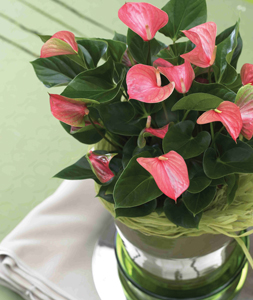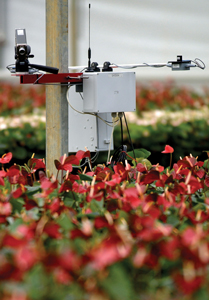1/15/2009
Anthurium: Easy to Grow and Easy to Love
Michael Van Rijn

Based on turnover in 2007, anthurium is ranked No. 3 in European pot plant sales. Because of its sub-tropic origin, nearly 100% of the crop is produced in modern glasshouses. In Northern America, anthurium has not yet achieved a Top 10 position in pot plant sales, although there should be good market openings. One of the big advantages of anthurium is the grower can easily control when the product is sold since holding the crop a few weeks longer in the greenhouse doesn’t damage the plant.
The newest trend for pot plant production is exclusivity contracts, and this includes anthurium. In the past few years the market situation for anthurium has improved since RijnPlant B.V. began giving select growers rights to grow specific RijnPlant PBR-protected varieties on a regional-exclusive basis. With this exclusivity program, the grower can produce an exclusive variety or varieties for a period of two to three years based on the contract. During this period the grower is the only one in his region (state, country or even continent) allowed to produce those varieties. That grower’s position in the market becomes much stronger since they can promote the product more efficiently.
The genus Anthurium belongs to the Araceae, or arum family, which also includes spathiphyllum, dieffenbachia and aglaonema and originates from the tropical rainforests of South America. The genus Anthurium is divided in various species, including Anthurium andreanum, Anthurium scherzerianum and Anthurium ellipticum.
The name stems from its inflorescence, which consists of a bract and a spadix that’s sometimes compared with a tail. The name comes from the Greek “anthos” (flowering) and “oura” (tail). The real flowers of the anthurium plant develop on the spadix and are visible as little lumps.
Crop culture
Anthurium is grown in pot sizes ranging from 3.5 to 14 in. Crop time depends on both pot size and the starting material. For example, crop time for plants grown in a 4-in. pot is 26 weeks, and 42 to 45 weeks when grown in a 6.5-in. pot.
Anthurium likes to have an airy soil mixture. The use of 50% coco peat, if properly prepared before use, is fine for cultivation. The cultivation of anthurium needs a pH level of 5.0-5.5 and an EC level of about 0.5 based on the 1:1.5 extraction method. The minimum temperature for anthurium is 61F (16C). Depending on the amount of light, the daytime temperature should be between 68F and 86F (20C and 30C). The relative humidity of the air should be maintained between 65% and 75% during the day and 80% to 90% at night. If necessary, a misting may keep the humidity at the recommended levels. Misting is allowed only during daytime.
Water. Anthurium can be cultivated on groundcloth, concrete ebb and flood floors or benches. When growing on groundcloth, irrigation is provided by an overhead system of water lines or sprinklers. On concrete flood floors, water can be supplied either by sprinklers or by flooding the floors. The water’s EC should be maintained between 1.0 and 1.6 for recently planted material and between 1.5 and 2.2 for older plant material, depending on the variety. Make sure the pot’s EC is within the range 0.4-0.7 based on the 1:1.5 extraction method. This also depends on the variety.
Sanitation. Anthurium crops may become infected by pests and diseases. To prevent infection, it’s imperative to maintain strict hygiene measures such as wearing special overalls and shoe coverings and requiring workers to wash their hands with disinfectant. If using recirculated water, purify it by means of reverse osmosis and UV light.
Light. The maximum allowable light intensity differs with variety. For varieties such as Leny and most varieties from the Love collection, maintain light levels between 9.000 and 12.000 lux (836 to 1114 f.c.). For varieties like Anouk, Pink Love and Baby Red, light intensity should be between 10.000 and 14.000 lux (929 and 1300 f.c.). Some varieties have a higher maximum light intensity: Red Queen, Red King and Red Love can be grown between 12.000 and 18.000 lux (1114 and 1672 f.c.). The lowest values must be in spring. Light intensity is now more commonly measured in micromols. Using this means of measurement, maintain light between 5 and 7 mol per day.
Biological controls: Commonly used biological controls for pot cultivation of anthuriums are: Hypoaspis miles, Amblyseius cucumeris, Amblyseius swirskii, Aphidoletes aphidimyza, Aphidius colemani and Aphidius ervi.
 GrowWatch
GrowWatch
Seven years ago RijnPlant started a project in the Netherlands to improve and share technical knowledge among anthurium growers. RijnPlant joined forces with an IT company to form Grow, which invested in a plant growth-measuring machine called GrowWatch. Equipped with plant sensors, GrowWatch measures PAR light, CO\sub2\ concentrations, leaf temperature and other factors. Another sensor called Plantivity calculates the amount of light used by a plant by measuring the amount of light falling on a leaf and the amount being reflected by the leaf. Plantivity can then calculate how much energy a plant is using, allowing it to calculate growth rate.
Every five minutes GrowWatch’s recorded data is sent to a data bunker in Amsterdam, the Netherlands. The advantage of GrowWatch is it’s capable of communicating worldwide in an instant. Users of GrowWatch can log in to the collected data, and advisors are able to instruct their growers on a weekly or even daily basis how to improve the growth of their crops. By optimizing the climate to the crop’s ideal growing condition, growers can improve quality, save energy and shorten the time needed to produce the crop. For more information see www.rijnplant.com and www.growwatch.nl.